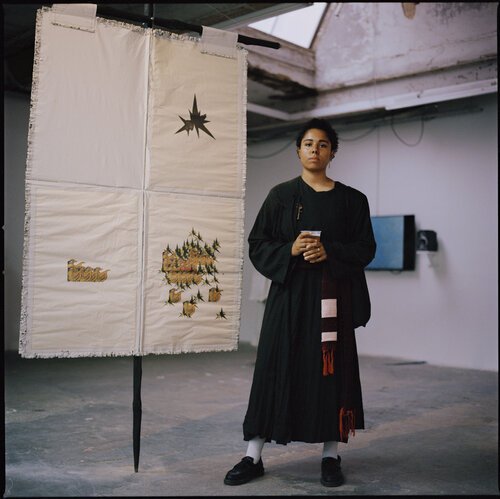
Tanoa Sasraku
29 July – 26 August 2021
Online Presentation
Alex Vardaxoglou shares an online Presentation featuring work by British artist Tanoa Sasraku (b. 1995), ahead of a physical exhibition at the gallery next year. The Presentation features a group of drawings related to Sasraku’s award-winning film, O’ Pierrot, 2019, recently shown at the British Film Institute, and which won Sasraku the Arts Foundation Futures Award earlier this year.
Through the narrative of Pierrot the Clown, and the aesthetic of Kenneth Anger’s pioneering avant-garde, queer film Rabbit’s Moon, O’ Pierrot explores the quest for British acceptance from a black British perspective. In Sasraku’s film, Pierrot Mulatto (played by the artist) is on a quest catch a giant sycamore seed that spins down every day from the arms of Harlequin Jack, a crazed black man in whiteface, driven mad by his own quest for British acceptance.
Jack toys with Pierrot throughout, performing a satirical essence of white British sensibility whilst referencing early minstrel troupes’ caricatures of the post-slavery, black populace. Mixed-race Pierrot is encouraged to strive for her ‘white potential’ whilst battling rejection, rage, and the bending of time amidst the English countryside. The story of the black, British experience: one driven by misplaced loyalty, melancholy, and historical reprise stands as a mirror to the traditional tale of Pierrot’s existence under Harlequin’s thumb. This forms the narrative pillar for Sasraku’s semi-autobiographical fairytale whilst the script is built upon a colliding of verses from the Jim Crow-era song ‘Jump Jim Crow’ and lesser-known passages from the British National Anthem.
Paul Legrand as Pierrot circa 1855
Sasraku in costume for her film ‘O’ Pierrot’ (2019). Photo: Lewis Brander
The drawings, made since the film’s production, explore Pierrot Mulatto’s attempted grasp of the sycamore seed from Harlequin Jack. Acting like stop-motion frames, they encapsulate much of the heart of Sasraku’s film, as well as its depicted subjects. The hand, an important tool of the artist and most essential way for humans to make their mark, acts here as a stencil around which crushed pigment is blown.
The hand works explore the act of giving and taking, and the historical connotations of this dynamic in the black British experience. Sasraku’s drawings also continue the art historical tradition of hands depicted both as a symbol of creation and subject of representation since their appearance in pre-historic cave markings. In her own drawings, Sasraku evokes the hand of the artist as her own, but via the character of those in her film, thereby creating a distance. It is this retelling of narratives through different media which plays a central role in her wider practice and interests; for example, the retelling of traditional folklore, as in O’Pierrot.
The other works emerge from Sasraku’s interest in the history of tartan, and its contemporary usage. They can be linked to another strand of the artist’s practice in which she draws and stencils tartan textiles, referencing artists such as Frank Stella and Peter Schuyff. The two drawings here reference the family tartan of Sasraku’s Scottish partner. As is thematic, by drawing these, Sasraku flips the normative tradition of ‘passing on the family tartan,’ and questions what it means to pass on a family tartan in a queer union. The structure of the tartan is flattened and simplified, as if a shadow of a cut-out.
In skewing the structure of the tartan, the works also become reminiscent of geometric woodcuts in Ghanaian furniture, which Sasraku remembers from her childhood home in Devon - placed around the house as a memento of her late Father and paternal, cultural heritage.
O' Pierrot (2019) 8mm film still
Hand Test III, 2020
soft pastel on cartridge paper
size of sheet: 42 x 29.7 cm / 16 ½ x 11 ½ in
(framed size: 48 x 35.5 cm / 19 x 14 in)
Hand Test IIII, 2020
soft pastel on cartridge paper
size of sheet: 42 x 29.7 cm / 16 ½ x 11 ½ in
(framed size: 48 x 35.5 cm / 19 x 14 in)
“As a filmmaker, Sasraku engages in queer, black retellings of traditional folklore, as well as producing more diaristic journeys through her past, via the medium of analogue film. The presence of her figure, set against the British landscape throws into question ideas of “deep” England and what it means to claim ownership over the rural.”
Test Black II, 2020
soft pastel on cartridge paper
size of sheet: 42 x 29.7 cm / 16 ½ x 11 ½ in
(framed size: 48 x 35.5 cm / 19 x 14 in)
Test Black I, 2020
soft pastel on cartridge paper
size of sheet: 42 x 29.7 cm / 16 ½ x 11 ½ in
(framed size: 48 x 35.5 cm / 19 x 14 in)
O' Pierrot (2019) 8mm film still
Hand Test II, 2020
soft pastel on cartridge paper
size of sheet: 42 x 29.7 cm / 16 ½ x 11 ½ in
(framed size: 48 x 35.5 cm / 19 x 14 in)
Hand Test I, 2020
soft pastel on cartridge paper
size of sheet: 42 x 29.7 cm / 16 ½ x 11 ½ in
(framed size: 48 x 35.5 cm / 19 x 14 in)
Biography
Tanoa Sasraku (b. 1995) lives and works in London, England. Her practice examines the intersections of her identity as a bi-racial, gay woman raised in Plymouth (UK) and shifts between filmmaking, drawing and flag-making, juxtaposing and performing British, Black, Ghanaian and queer cultural histories. She graduated from the BA Fine Art course at Goldsmiths College in 2018 and will be commencing her studies at the Royal Academy Schools in 2021. Recent exhibitions include: General Release, Chelsea Sorting Office, London, 2021; Klosterruine, Berlin, 2020; Tate St. Ives, 2019.
Article
Financial Times, 23 January 2021
Article











